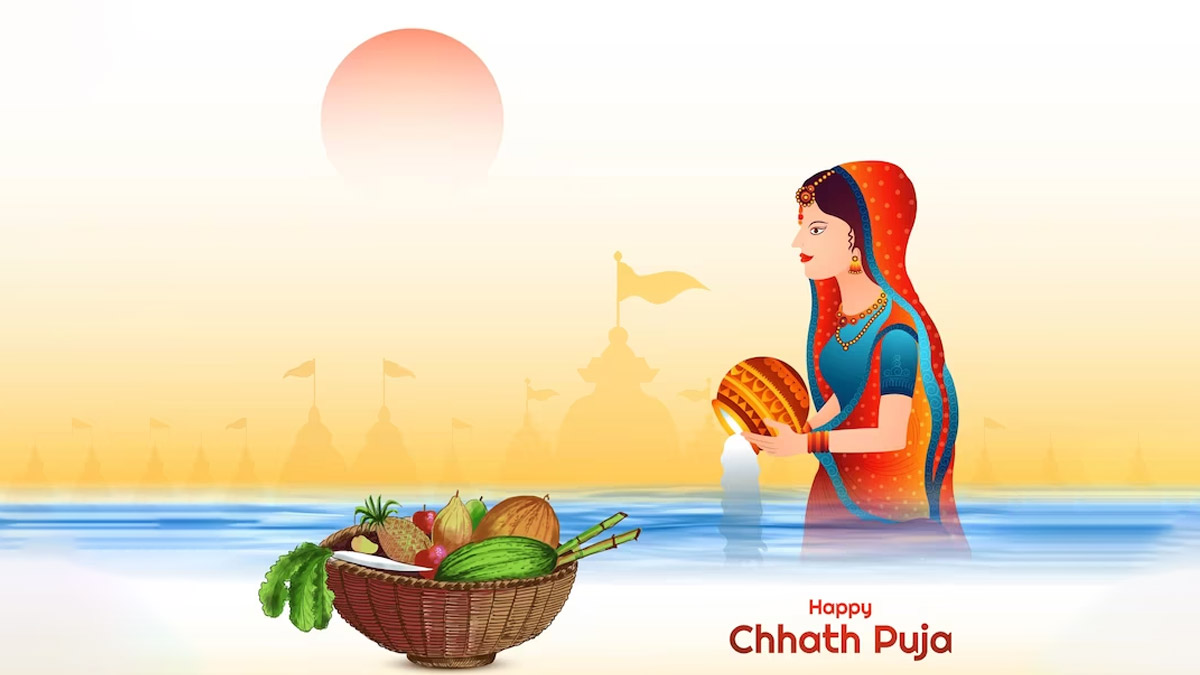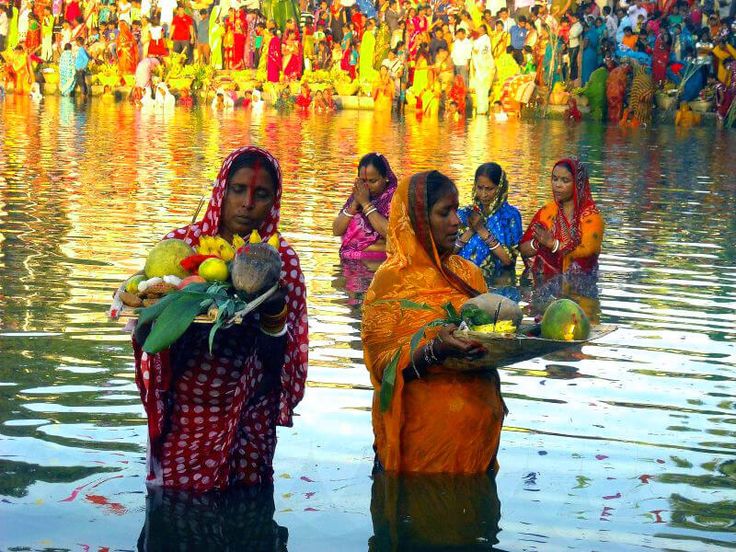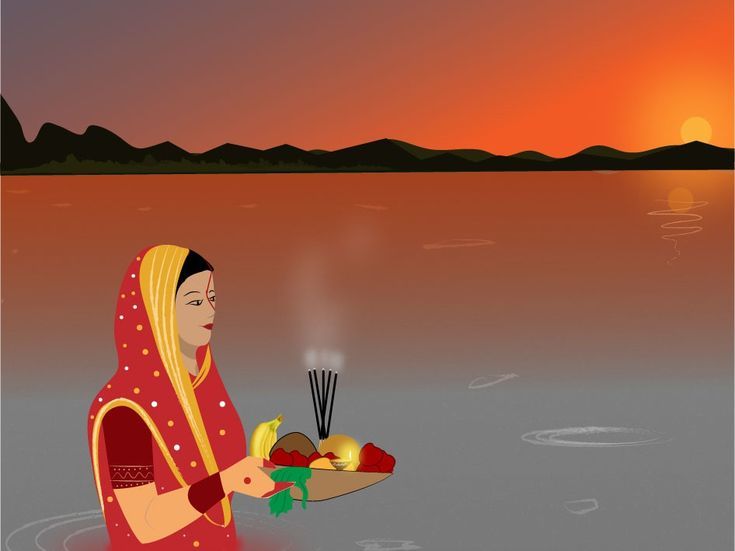How to do Chhath Pooja | 2024 | Chhath Puja Date

Chhath Puja is a Hindu festival dedicated to the worship of the Sun God, Surya, and Chhathi Maiya, the Goddess of Chhath. Celebrated with great enthusiasm and devotion, this ancient Vedic festival is observed primarily in the northern regions of India, particularly in the states of Bihar, Jharkhand, Uttar Pradesh, and the Terai region of Nepal. Chhath Puja typically takes place six days after Diwali and spans four days of rigorous rituals and customs. In this article, we will delve into the step-by-step process of how to perform Chhath Puja.
Important Tips for Chhath Puja:
Purity and Cleanliness: Maintain purity during the entire process. Take a ritual bath before starting the puja and ensure that the surroundings are clean.
Fasting: Devotees observe a strict fast during Chhath Puja. It is essential to abstain from food and water as a mark of devotion and penance.
Traditional Attire: Wear traditional clothing, especially for women who often dress in colorful sarees. It adds to the spiritual ambiance of the puja.
Chhath Songs and Mantras: Learn and chant the specific Chhath songs (Chhath Geet) and mantras during the rituals. These are considered auspicious and help in invoking divine blessings.
Chhath Puja is a celebration of life, energy, and devotion to the Sun God. The rigorous rituals and fasting during these four days symbolize the unwavering faith and gratitude towards nature. By following the prescribed customs with sincerity and purity, devotees connect with the divine and experience a sense of spiritual rejuvenation. This ancient festival not only strengthens family bonds but also fosters a deep connection with the elements of nature.
Nahay Khay

Nahay Khay is the first day of the Chhath Puja festival, and it holds significance as it marks the beginning of the four-day-long worship. The name "Nahay Khay" itself translates to "bath and eat," reflecting the primary activities of this day. Devotees engage in purifying rituals, including taking a holy dip in a sacred river or pond, and preparing a special meal as an offering to the Sun God.
Here are more details about the Nahay Khay rituals:
Holy Bath (Nahay):
- Devotees wake up early before sunrise and head to a nearby riverbank, pond, or any clean water body for a ritualistic bath. The Ganges River is considered highly auspicious for this purpose.
- The bath is not just a physical cleansing; it symbolizes the purification of the mind and soul. It is believed that taking a dip in the holy waters on this day helps wash away sins and impurities.
Preparation of Prasad (Khay):
- After the bath, devotees wear clean and fresh clothes. Women, especially those observing Chhath, typically wear traditional sarees, and men may wear dhotis.
- The next step involves preparing a special meal that will be offered to the Sun God during the evening prayer. The meal typically includes rice, lentils, and pumpkin. The preparation is done with great care, emphasizing cleanliness and purity.
Offering to the Sun:
- In the evening, as the sun begins to set, the devotees gather at home or at a designated prayer area. They prepare a small platform (chhat ghat) where the offerings will be placed.
- The freshly prepared meal, along with fruits and other traditional items, is offered to the setting sun while chanting Vedic mantras. The act symbolizes gratitude to the Sun God for sustaining life on Earth.
Prayers and Devotion:
- During the entire process, devotees maintain a sense of deep devotion and humility. The prayers are heartfelt expressions of gratitude and seek blessings for the well-being of the family, prosperity, and good health.
- The atmosphere is charged with spirituality as families come together to participate in the rituals, creating a sense of unity and shared faith.
Observance of Fasting: While Nahay Khay is not a day of complete fasting, it is customary for the observers of Chhath Puja to follow a simple and sattvic (pure) diet. The focus is on consuming pure and vegetarian food that aligns with the spiritual nature of the festival.
Nahay Khay sets the tone for the subsequent days of Chhath Puja, creating a spiritual and purified mindset for the devotees as they embark on the rigorous rituals and fasting that follow in the coming days. The emphasis on cleanliness, purity, and gratitude is a central theme throughout the Chhath Puja celebrations.
Kharna

Kharna is the second day of the Chhath Puja festival and involves a day-long fast that is broken in the evening after sunset with specific rituals. Devotees abstain from food and water throughout the day, displaying their dedication and commitment to the Sun God, Surya. The fasting on this day is considered a form of penance and purification.
Here are more details about the Kharna rituals:
Beginning the Fast:
- Devotees wake up early on the Kharna day and take a ritualistic bath, similar to the Nahay Khay day. Cleanliness is emphasized as a symbol of purity.
- After the bath, devotees wear fresh and clean clothes, often opting for traditional attire.
Observance of Fast:
- The day is marked by a strict fast, where devotees abstain from consuming both food and water. This fast is observed as a form of self-discipline, penance, and purification.
- The fast is undertaken with a sense of devotion and surrender, symbolizing the willingness to endure hardships for the sake of spiritual growth.
Preparation of Prasad:
- The focus of the day is on the preparation of the prasad (offerings) that will be consumed after the fast is broken. The prasad typically includes kheer (sweetened rice pudding) made with jaggery, along with fruits like bananas and apples.
- The preparation is done with great care and purity, similar to the rituals observed on Nahay Khay.
Breaking the Fast (Kharna Ritual):
- The fast is broken after the evening prayers and the sighting of the moon. The devotees offer the prepared prasad to the Sun God before partaking in the meal themselves.
- It is customary for the observer of the fast to break it along with family members or in the presence of fellow devotees, fostering a sense of communal harmony.
Offering to Chhathi Maiya: Along with offering to the Sun God, some devotees also perform rituals and offer prayers to Chhathi Maiya, the Goddess associated with Chhath Puja. This includes seeking her blessings for the well-being and prosperity of the family.
Expression of Gratitude: The breaking of the fast and the subsequent meal are accompanied by expressions of gratitude and prayers for the fulfillment of wishes and blessings for the family.
Kharna, with its emphasis on fasting, purity, and gratitude, prepares the devotees for the more rigorous rituals of Sandhya Arghya and Usha Arghya that follow on the third and fourth days of Chhath Puja. It is a day of self-discipline, reflection, and spiritual contemplation, reinforcing the devotees' commitment to the divine.
Sandhya Arghya

Sandhya Arghya is the third day of the Chhath Puja festival and holds paramount significance as the main day of the entire celebration. On this day, devotees gather in large numbers on the ghats (riverbanks) to make offerings to the setting sun. Sandhya Arghya involves a series of rituals performed during the evening, and it is considered the most crucial phase of Chhath Puja.
Here are more details about the Sandhya Arghya rituals:
Preparation and Fasting:
- The day begins with devotees observing a day-long fast, similar to the one on Kharna day. Fasting during Sandhya Arghya is a symbol of devotion, self-discipline, and spiritual purification.
- The observers of the fast spend the day in prayer, meditation, and reflection.
Gathering at the Ghat:
- As the evening approaches, devotees, dressed in traditional attire, gather at the ghats near a water body, preferably a river or pond. The atmosphere is charged with anticipation and devotion.
Chhath Ghat Setup:
- Devotees create a temporary platform known as "chhat ghat" at the water's edge. This platform is used for performing the rituals and making offerings to the Sun God.
- The setting is meticulously prepared, and cleanliness is maintained throughout the area.
Offerings to the Setting Sun:
- The main ritual involves offering "Arghya" to the setting sun. Devotees stand in the water and make offerings to the Sun God, expressing gratitude for the energy and life provided to the Earth.
- The offerings typically include thekua (a traditional sweet), fruits, sugarcane, coconuts, and other traditional items.
Chanting of Vedic Mantras:
- While making the offerings, devotees chant Vedic mantras dedicated to the Sun God. The mantras are considered sacred and play a crucial role in invoking divine blessings.
- The chanting creates a spiritually charged atmosphere, and the collective recitation enhances the sense of unity among the devotees.
Prayers and Devotion: The entire process is accompanied by heartfelt prayers for the well-being of family members, prosperity, and the fulfillment of wishes. Devotees express their gratitude for the Sun God's benevolence and seek blessings for the upcoming year.
Observance of Strict Purity: Throughout Sandhya Arghya, devotees maintain strict purity, both in terms of physical cleanliness and spiritual mindset. The emphasis on purity is considered essential for the success of the rituals.
Community Participation: Chhath Puja is not only a family affair but also a community celebration. The ghats are filled with devotees, and the collective energy enhances the spiritual experience.
Sandhya Arghya marks the pinnacle of Chhath Puja, and the rituals performed on this day are believed to have a profound impact on the well-being and prosperity of the devotees and their families. The setting sun symbolizes the completion of the day's festivities, and devotees return home with a sense of fulfillment and spiritual rejuvenation.
Usha Arghya

Usha Arghya is the fourth and final day of The Chhath Puja festival, and it involves making offerings to the rising sun. This morning ritual is a culmination of the four-day-long Chhath Puja celebration and is considered as important as the Sandhya Arghya performed on the previous evening. Usha Arghya is observed at sunrise, and it signifies the end of the rigorous fasting and rituals undertaken by devotees.
Here are more details about the Usha Arghya rituals:
Preparation and Fasting:
- Similar to the previous days, devotees wake up before sunrise on the day of Usha Arghya. The morning fast is observed, symbolizing the final day of devotion and penance.
- The fasting period is usually concluded after the morning rituals.
Traveling to the Ghat:
- Devotees, adorned in traditional attire, make their way to the ghats or riverbanks in the early hours of the morning. The journey is often accompanied by family members and fellow devotees.
- The atmosphere is serene, with the anticipation of witnessing the sunrise and offering prayers to the Sun God.
Chhath Ghat Setup: At the ghat, devotees set up the chhat ghat, a temporary platform, for the morning rituals. Similar to the Sandhya Arghya setup, cleanliness and purity are maintained throughout the area.
Offerings to the Rising Sun:
- As the sun begins to rise, devotees stand in the water and make offerings to the rising sun. The offerings include thekua (a traditional sweet), fruits, and other items symbolizing gratitude and devotion.
- The act of offering to the rising sun is believed to bring blessings for the prosperity, health, and happiness of the devotees and their families.
Chanting of Vedic Mantras: Devotees continue to chant Vedic mantras dedicated to the Sun God during the Usha Arghya rituals. The mantras are considered sacred and enhance the spiritual connection with the divine.
Expression of Gratitude and Prayers:
- Usha Arghya is a time for expressing deep gratitude for the successful completion of the Chhath Puja rituals. Devotees thank the Sun God for the energy and life provided to the Earth.
- Prayers are offered for the well-being of family members and for the fulfillment of wishes in the coming year.
Breaking the Fast: After completing the morning rituals, the fast observed during Usha Arghya is typically broken. Devotees partake in a simple and pure meal, concluding the period of fasting and penance.
Community Celebration: Similar to Sandhya Arghya, Usha Arghya is often celebrated as a community event. Devotees gather at the ghats, and the morning rituals create a sense of collective spiritual energy.
Usha Arghya marks the conclusion of Chhath Puja, and devotees return home with a sense of accomplishment and spiritual satisfaction. The festival not only strengthens family bonds but also fosters a deep connection with nature and the divine energies associated with the Sun God.





